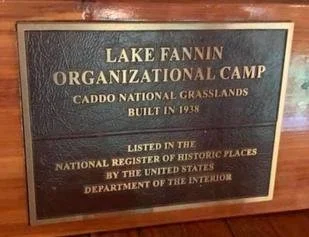Lake Fannin Organization Camp
The Lake Fannin Organization Camp was added to the National Register of Historic Places in 2001.
The following is a portion of Registration Form for this designation:
The Lake Fannin Organization Camp, built between 1936 and 1938, was the first Resettlement Administration (RA) project of its size in the United State and the only one of its kind in Texas attributed to the RA. Planning began in 1933 or 1934, under the direction of Fannin County RA director Malcom Campbell. At the time soil depletion and erosion had rendered much of the agricultural land in north Texas useless. In an attempt to halt the erosion of soils, an existing lake on the property was drained and a new, larger lake was built. Construction of this dam began in early 1936, and by the fall of that year, ten of the sixteen overnight cabins had been completed. The entire complex was completed by January of 1938. The over 400 workers employed in the construction of the site, planting and furniture making, were hired from the Fannin county relief rolls. The lake construction, coupled with sodding, terracing and installation of smaller check dams, was successful in controlling erosion, and the area served as a popular public recreation site until 1956.
Contextually, the Lake Fannin Organizational Camp relates to the Rustic style of architecture made popular during the New Deal era.
The camp is significant in the area of Politics and Government in that it is representative of New Deal era public works projects. An account in the June 23, 1936 issue of the Bonham Daily Favorite attributes the authorization of this project, along with several others in Fannin County, to the efforts of Congressman Sam Rayburn, further enhancing its significance in this area.
The camp layout, architectural and design elements, and building materials are all distinctive to planned landscapes created by federal public works projects during the 1930s, thus the camp is significant in the area of Landscape Architecture. The camp possesses significance in the area of Conservation as an example of the successful effort in the reclamation and conservation of badly eroded, unproductive submarginal agricultural lands. The selection of this particular site for this camp was predicated on the desire to stem the ravaging effects of soil erosion, caused by many years of agricultural overuse and compounded by dramatic shifts in weather patterns resulting in what is terms the "Dust Bowl era."
The camp also is significant in the area of Entertainment/Recreation, as it provided the residents of Fannin County an important recreational resource that was not available prior to its construction.
The association of the Lake Fannin Organizational Camp with New Deal era public works reclamation and conservation projects, its association with Congressman Sam Rayburn, its embodiment of Rustic design elements incorporated into a planned landscape, and its role in providing previous unavailable recreational resources to the local residents, make the camp eligible for the national Register of Historic Places under Criteria A and C at the state level of significance in the period 1933-56. The continuity of use as a public recreation facility into the mid-1950s, and certain modifications to several structures as a result of the change in use patterns at that time, is reason for extending the period of significance beyond the 50-year age requirement.
_____________________________
In April 1935 . . . President Roosevelt signed an Executive Order creating the Resettlement Administration . . . [I]n the desolation that was north Texas during the Depression, the RA implemented two Land Utilization Projects in Fannin County, Lake Fannin and Lake Davy Crockett, designed to help put the unemployed into gainful work while rehabilitation and restoring highly eroded sub-marginal agricultural lands. There were also a Civilian Conservation Corps project (Bonham State Park) and Works Progress Administration (Bonham High School Gymnasium) project in Fannin County at this time. This seemingly dense concentration of federal projects in a small north Texas county was no doubt attributable to the influence of then House Majority Leader Sam Rayburn.
_____________________________
The land for the Lake Fannin Organizational Camp was originally purchased by the city of Bonham in 1900 for the purpose of constructing a county club. By 1930, a small lake had been constructed , but further development was delayed when the local economy worsened; the small dam eventually burst and the lake dried up, becoming a catch basin for soils being eroded from the adjacent hillsides. The main goal of the RA Land Utilization Project at this location was to halt the erosion, restore productivity for lands that were sub-marginal for agricultural production, and, in the process, provide an opportunity for meaningful employment and enjoyable recreation experiences for the citizens of Fannin County. The newly constructed 75-acre lake, with its lodge, overnight cabins and other amenities, quickly became the focal point of the area, but it was the terracing and revegetation of the surrounding hillsides that eventually halted the erosion and restored the land. Lake Fannin became a popular leisure spot, even before the construction of all facilities was completed. By the summer of 1940, the complex would receive hundreds of visitors per weekend, weather permitting.
